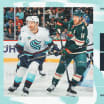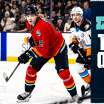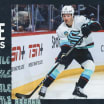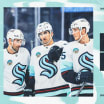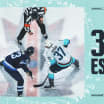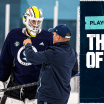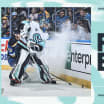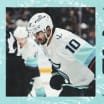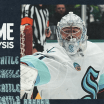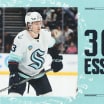When the 2020 NHL Free Agency period began at 9 a.m. last Friday, the general managers of 30 teams took to plotting how to find just the right players to add to their rosters to match the accomplishment of the Tampa Bay Lightning, who won the Stanley Cup two weeks ago. Tampa Bay's front office took a night to celebrate, then went straight back to work to draft prospects Oct. 6 and 7 while also juggling what players to re-sign from their championship and which free agents to consider as additions for a Cup defense next season.
Kraken general manager Ron Francis and his hockey operations staff are closely monitoring the free agency market. It is likely less than a year from now, maybe just nine months from now, that the scouting and analytics staff will be in final preparations for-in quick succession-drafting one player from 30 teams (Vegas excluded) to create an expansion team roster, drafting prospects (picking no lower than No. 4 in first-round draft order, so that might translate to the rare 18-year-old who sticks on the NHL roster for the year) and then potentially signing free agents from all 31 teams.
Change Agents
Teams began signing NHL free agents last Friday to strengthen their rosters. Here's a guide on how the league's general managers are remodeling their franchises. Plus, turn heads by knowing the terms 'UFA' and 'RFA'
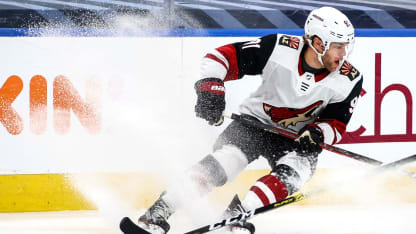
It's all exciting and feeling real. Kraken team broadcaster Everett Fitzhugh welcomed fans back to a post-Draft Round 1 livestream by emphasizing the Oct. 6 opening round was the last time the NHL would conduct one without the Seattle franchise. The Kraken will be a lottery team for the 2020 NHL Draft for prospects, picking 1-2-3-or-4 depending on how the ping pong ball drops, and third in order for Rounds 2 to 7. Then the Seattle squad will suit up and become an official part of the hockey's history scoresheet for the 2021-22 season.
New NHL @TheRink with @ArizonaCoyotes GM Bill Armstrong & https://t.co/lf7CgbHFsN's Nick @cotsonika
— NHL.com (@NHLdotcom) October 8, 2020
- Armstrong on OEL & Taylor Hall's future
- State of free agency & trade market
- Goalie carousel.. Hank's landing spot
- Who signs Pietrangelo & Krug? https://t.co/GiX8rrV8tj
The NHL Free Agency period has many doors the you can open to learn about how it impacts your favorite team's chances for a Cup and why the first day-usually July 1 but this unprecedented year Oct. 10-keeps hockey fans glued to their devices for hockey signings news. Let's explore some of those entry points.
The Foundation
No house can have doors without a foundation below it. We start with the classification of players as unrestricted free agents and restricted free agents. Call them UFAs and RFAs and you will already be more prepared to talk free agency with hockey-fan friends. Unrestricted free agents or, say it together with us, UFAs, can sign with any team with no obligation to the players' former teams.
In some cases, the UFA player becomes so because his team doesn't want to re-sign after an initial or subsequent contract runs out. Maybe the player is aging and the team doesn't believe a longer-term contract is merited. Possibly the player is still valuable but wants too much money per year to fit under a team's salary cap (which is basically a number all teams must stay below per each roster on game nights). Other times, the UFA status is a player's choice. He might want to change locales or management situations, or he might want to test the free agent market for highest dollars.
The RFA status is a bit more complex but basically in place to allow younger players to gauge their worth on the free agent market while protecting the teams who drafted (or maybe traded for while still prospects) and developed that player. RFAs more often than not stay with their original team with a contract that boosts their pay, sometimes at big numbers and other times as a one-year "bridge contract" that increases salary, keeps good will, then still allows the player to seek a UFA deal the following summer (those "bridge-contract" players will no doubt be intriguing to watch during this free agency period.
This next paragraph is optional, feel free to skip to the "Front Door" next section.
You want to know more about RFAs? Here it goes: A player who is drafted or signs an entry-level contract with a team has his contract rights You want to know more about RFAs? Here goes. A player who is drafted or signs an entry-level contract with a team has his contract rights retained by that team for seven years or until they are 25, whichever comes first. Once a player has reached the seven-year mark or turns 25, he becomes a UFA. if their contract expires. The RFA status occurs most with young players who have played at the NHL levels in 18, 19 or 20. Those RFAs can sign with any team but the current team can match the contract to keep the player. If they choose to let the player sign with another team, the signing team must give up draft picks that match the compensation level of the contract. OK, enough, let's open the Front Door.
Front Door
When we enter our dream house, we want splendor and light and a generous view of what awaits. Applied to NHL Free Agency, this converts to a list of the top free agents on the market. NHL GMs can evaluate their spending level (think mortgage calculator) then decide what players (think number of rooms, features, etc.) fit the budget. Here's a quick-look at top UFAs that will be signed in the coming days.
Alex Pietrangelo, defenseman, St. Louis Blues: He captained the 2019 Stanley Cup winner and he's a right-shot defenseman who can score and defend (16 goals and 36 assists last season]. He's 31, which might scare off some suitors and clearly influenced the Blues to not re-sign him. This week, the Vegas Golden Knights went all-in with Pietrangelo with a seven-year, $61.6 million contract that analytics experts will likely question such high salaries in the defenseman's plus-35 years of age.
Taylor Hall, forward, Arizona Coyotes: A former No. 1 overall pick, now 28, he won the Hart Trophy in 2017-18 with a 93-point season. His performance has not consistently matched his potential and injuries might factor into his money and term of contract. But he will be strongly pursued. Hall signed a one-year, $8 million deal with Buffalo, possibly in hopes that the free agent market will be more robust next summer if fans (and in-arena revenues) return during the 2020-21 season targeted to begin Jan. 1
Torey Krug, defenseman, Boston Bruins:. Krug is an offensive threat, especially running the power play. He surprised hockey insiders and the aformentioned Petrangelo by signing a first-day long-term deal with St. Louis.
Mike Hoffman, forward, Florida Panthers, and Evgenii Dadonov, forward, Florida Panthers:Both players are a bit under-the-radar among NHL fans. Hoffman led all UFAs with 29 goals last season. He can be on the first line for many teams. Dadonov, naturally nicknamed "Dad" by teammates, stuck for good on an NHL roster at 28. Three years later, he has notched 182 (81 G, 101 A) in 225 games. He has yet to sign; media reports say Boston is the most interested.
Security System
Not technically a door, but every house or team needs to protect its net. This offseason's choices among UFA goalies is plentiful and should draw interest from NHL GMs and, yes, Kraken fans. A formidable number of No. 1 and former No. 1 starting goaltenders switched franchises during the last week, along with a pair of notables who stayed with their teams:
The first weekend of free agency clarified most questions about where top free-agent goalies would work in the crease (the rectangular domain in front of each net). The most high-profile signing was former Vancouver No. 1 goaltender Jacob Markstrom signing with Pacific Division and interprovincial rival Calgary Flames on a six-year deal with gaudy numbers compared to other goalies who signed free agent contracts. The Pacific-Division Flames get the No. 1 goalie their management considers a missing piece to legitimate Stanley Cup contention.
Other goalie signings clicked into place like the combination on a lock: 2018 Cup winner Braden Holtby signed a two-season contract with Vancouver to pair with rookie playoffs star Thatcher Demko; ex-Calgary starter Cam Talbot moved to the Central Division and the Minnesota Wild; long-time New York Rangers goalie Henrik Lundqvist (15 seasons) took a one-year deal with Washington in hopes of living out his hockey wish of a winning a Stanley Cup before he retires; Corey Crawford, 35, two-time Cup winner with Chicago, joins the New Jersey Devils on a two-year to work in tandem with the promising MacKenzie Blackwood, who has played in 47 NHL games. Two star goalies (and unrestricted free agents) from the just-completed playoffs, Robin Lehner of Vegas and Anton Khudobin of Dallas, re-signed with their respective teams with substantial contracts.
Patio Door
Every house needs a deck or place to step outside to gaze the horizon. While we can't quite see Vancouver from our porches and decks, we sense it is nearby. Here are two Canucks players in the UFA mix.
Tyler Toffoli, forward, Vancouver Canucks: A veteran who helped solidify Vancouver's potent offense. He scored six goals in 10 regular-season games when traded from Los Angeles at the 2019-2020 season's Trade Deadline. His clutch scoring in the playoffs will help the 28-year-old land somewhere with security. He signed a four-year deal with the Montreal Canadiens, which appeared to be his preferred choice.
Christopher Tanev, defenseman, Vancouver Canucks:While not a higher scorer (20 point this past season is a career high), he is reliable on the defensive end. His skills on the penalty-kill unit and blocking shots persuaded Calgary to add him to their backline on a four-year contract.
Side Door
Along with former Pittsburgh goalie Matt Murray taking his two Stanley Cup wins to Ottawa, other players were traded because the free agency period opened because its teams didn't see how they could sign the player and stay under the salary cap. Montreal forward Max Domi is one example. He was traded to Columbus, which promptly awarded him with a two-year contract at a dollar amount Domi clearly liked.
Back Door
We all recognize the back entry to the house as familiar and comforting. Along with Lundqvist agreeing to a backup goaltender role at 38, here are two UFAS most any team would love to fortify and mentor a roster at the right price. Both just won a Cup with Tampa Bay.
Kevin Shattenkirk, defenseman, Tampa Bay Lightning: Shattenkirk, 31, was considered an elite offensive-minded defender for years. Scouts say he has lost speed, which affects his defense, but 13 points in 25 playoff games-including a huge double overtime winner-might help his cause. He is a positive force in the TBL lockerroom. Shattenkirk signed a three-year deal with Anaheim at what hockey insiders deem a bargain at less than $4 million yearly. The d-man instantly improves Anaheim's man-advantage situational scoring, which was second worst in the league last season.
Patrick Maroon, forward, Tampa Bay Lightning: He calls himself the "Big Rig" and certainly brought physicality to the Lightning's postseason success along with beloved status among players. At 32, Maroon's leadership qualities will continue to bolster the Lightning's younger players since the "Big Rig" signed up with TBL for another season at $900,000.





